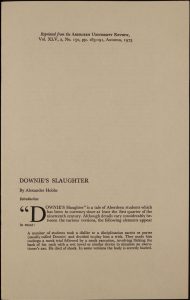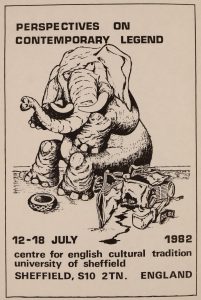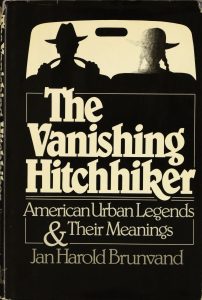Alexander (Sandy) Hobbs is a significant donor and friend of GCU Archive Centre. In July this year, he received the Linda Dégh Lifetime Achievement Award for Legend Scholarship by the International Society for Contemporary Legend Research. His research in this area is part of the Sandy Hobbs papers. Congratulations to Sandy from the Archive Centre team.
My long association with “Urban Legends” starts in my childhood in Aberdeen, when my grandmother told me a story generally called “Downie’s Slaughter”. At the time it was just something my granny talked about, but later I came to see it as an example of what I came to realise people mean by the name “Urban Legend”.
Let us put the story aside and move on to 1954 when, at the age of 17, I entered Aberdeen University, planning to study Psychology. My choice of this subject was based on a quite inadequate understanding of what Psychology was as an academic discipline. It became clear to me that there was a strong movement, particularly in the United States, to make Psychology an experimental science. Teaching on the course included taking part in demonstration experiments. One which particularly interested me was called Serial Reproduction.
Six students sit in a circle round a table and act as subjects. Each student is given a different short piece of text to read in a few minutes. Putting the text aside, each student writes from memory a version of what they have just read. What is written is then passed to the student on the left, whilst receiving a version of a different text from the student on the right. This process is repeated until there are six successive versions of each original texts. The differences between the versions and the originals are then considered and discussed.
This was presented to us as providing information relevant to the understanding of rumours and how they spread. The set-up I have described does not cover all aspects of rumour transmission in real life. However, it complements information one may gather in a natural setting. One asset of the experiment is that we know what the original story was, something not usually available if we are studying an actual rumour. One particularly noteworthy finding in the Serial Reproduction experiment is that, although the general tendency is for the texts to become progressively shorter, there is also clear evidence of material being added.
One discovery I soon made was that the study of rumour was not a major area of psychology. There seemed little prospect of making this a professional speciality if I were to follow a career in psychology. Initially, my interest in this area was in effect a hobby.
Now let us return to my granny’s story. It concerns a senior porter at the University whose officious manner led him to be disliked by many students. A group of them decided to play a practical joke on him. They rigged up a classroom as a courtroom and subjected him to a mock trial, the outcome of which was a sentence of death. He was blindfolded and forced to bend over. The climax of the prank was to bring a wet towel down on his neck. However, he died of shock.
Talking to some fellow psychology students, I became aware that this story was quite well known amongst Aberdeen students and it existed in varying versions. My friend Billy Brown and I set about collecting different versions and naturally looked at them in the light of what Serial Reproduction experiments had told psychologists. We also looked at earlier printed sources for the story.

Front cover of article ‘Downie’s Slaughter’ by Sandy Hobbs in the ‘Aberdeen University Review’, 1973
Some of our student informants believed that the events in the story happened quite recently. However, the earliest printed source for the story turned out to be the early 19th century. As well as the oral versions we collected we had printed texts ranging over a century. Considering these versions we found, as in the Serial Reproduction experiment, some elements dropped out over time and other elements became added. Downie’s Slaughter became the first legend about which I published a detailed analysis.
However, it was by no means the only story I was developing an interest in, and not necessarily the most typical. Another story I picked up on at this time concerned men laying a fitted carpet. Taking a break, one of them realised he had lost a packet of cigarettes. They then notice a small bump under the piece of carpet already laid. This, they thought, must be the cigarettes, so rather than spend time rescuing them and do the work over again, they stamped on the bump until it disappeared. Then the homeowner appeared, saying that her pet budgie had disappeared….
At this point I think it may be useful to list some of my relevant publications from the 1960s and the 1970s.
- The Modern Folk Tale, Chapbook, 1966
- Downie’s Slaughter, Aberdeen University Review, 1973
- Xmas Pack of Lies, Glasgow News, 1974
- The Strange Saga of Little Albert, New Society (with David Cornwell), 1976
- The Folk Tale as News, Oral History, 1978
Throughout this period, I was on the lookout for examples of these stories, but also for people who might share my interest in them. Like many socialists at the time, I was interested in folksong. Chapbook was a small magazine devoted to Scottish song, and I was chancing my arm by submitting the piece on modern folk tales, but it was accepted. Not only that, but I got some correspondence from readers.
I joined two British societies I hoped would be helpful to me, the Folklore Society and the Oral History Society. The former was initially of little help. A paper I submitted was rejected, probably rightly, on reflection. The OHS, by contrast, actually invited me to submit an article to their journal, hence The Folk Tale as News.
Glasgow News was a small radical newspaper with which I was involved. I had written articles on different topics which concerned me, so when the editor was on the lookout for material for a Xmas issue, I took the opportunity to outline modern folk tales in a lighthearted way.
Of these articles I have listed, Little Albert stands out for two reasons. One is that it was published in by far the most widely circulated of the publications, New Society. The other is that the main focus is not on what I was calling at the time “modern folk tales”. My friend David Cornwell and I looked at how one of the most famous pieces of research in 20th century psychology, the conditioning of a child, referred to in the original paper as “Albert B”, was described in textbooks and other secondary sources. We found that crucial details were often changed, new elements were added, and of course the formal “Albert B” usually became the cosier “Little Albert”. In our analysis we suggested similar processes were at work as could be seen in the circulation of folk tales and rumours.
Let us move into the 1980s. One of the few people I knew in Scotland who treated these stories as seriously as I did was Gordon McCulloch. Gordon was a quite well-known folksinger. When David Buchan came back from Canada to Stirling University to start teaching a folklore course, Gordon enrolled. He chose contemporary Scottish lore as a specialist topic, so unlike me he was for a time an officially recognized researcher in this academic field.

Poster for ‘Perspectives on Contemporary Legend’ conference, 1982
In Spring 1982, Gordon invited me out for a drink. His main goal was to persuade me to go with him to a conference which would be taking place later that year in Sheffield. The subject was to be “Contemporary Legends”. This sounded attractive, but there was a problem. As I noted before, the Oral History Society had seemed to me a hopeful environment in which to work. I had already committed myself to attend an international oral history conference in Aix-en-Provence.
Gordon went to Sheffield without me, but thanks to him I had a small impact there. One of the speakers was Jan Harold Brunvand, who had the previous year published a book called The Vanishing Hitchhiker: American Urban Legends and Their Meanings. In his conference paper, Brunvand put forward a hypothesis about the origin of a story called the Choking Doberman. Gordon drew his attention to something I referred to in The Folk Tale as News, which contradicted his theory. As Brunvand explains in his next book, The Choking Doberman, this led him to adapt his theory.
Brunvand went on to publish several books on what he calls Urban Legends. For a time, he had a syndicated newspaper column on the subject, which led him to amass a large correspondence on the subject, including a wide variety of stories. He may be regarded as the major figure in this field of research. He is probably also responsible for the widespread use of the phrase “Urban Legend”.
There is not much enthusiasm amongst scholars in the field for that term. The Sheffield conference in 1982 became the first of an annual series. A series of books Perspectives on Contemporary Legend appeared carrying papers from the early conferences. The International Society for Contemporary Legend Research was founded. Now it organizes the conferences and publishes the journal, Contemporary Legend.

Front cover of ‘The Vanishing Hitchhiker’ by Jan Harold Brunvand, 1981
At this point, I think it would be appropriate to discuss names. Brunvand was using the term “Urban Legend”, but other scholars appear to prefer “Contemporary Legend”. In fact, the are other possibilities. Gilian Bennett and I wrote a paper on CRUMB legends, referring to the adjectives we had seen employed, Contemporary, Rumour, Urban, Modern and Belief. I had been writing about “Modern” folk tales. “Modern” and “Contemporary” are used almost interchangeably. “Legend” is not the inevitable noun to use (story, myth, folk tale and meme are also employed) but is widely preferred amongst folklorists who regard legends as a subcategory of folk tales, which can be distinguished from more fantastic stories such as fairy tales.
The use of “Urban” seems to have arisen because, traditionally, folk tale collectors had found their material in rural communities. However, I don’t see any good reason to tie the stories discussed to towns. The phrase “Urban Legend” has achieved wide currency, however. A Google search for it I made found over nine million hits. “Contemporary Legend”, by contrast, produced only 58, 000. In calling my collection “Urban Legend” I am simply respecting common usage.
Since the early 1980s, my activities in this field have changed greatly. Meetings have allowed me to come face to face with other people who share my interest. A sense of community was fostered by newsletters. FOAFtale News, first run by Paul Smith who organized the first Sheffield conference, and later run by the new legend society, took its name from the jokey description of the stories as attributed to a Friend Of A Friend. There was also a newsletter founded by Gillian Bennett, which had a number of different names, but finally settled down as Letters to Ambrose Merton. I helped to edit it for a time. Most, but not all, of what I wrote on this subject, appeared in these publications. I was now no longer introducing readers to the subject but writing for an audience already interested.
My Urban Legend Collection consists of notes, correspondence and publications I amassed over the years. I did not set out to create a Collection. This is simply the material that I worked with. “Urban Legend” is not a precise scientific term. Hence, I had to make decisions about which items in my study I should select. As well as Little Albert, I have studied variations in secondary accounts of famous pieces of psychology, such as the Hawthorne Effect and Maslow’s Hierarchy of Needs. Material on these remain at home but could justifiably have been in the collection because my research showed similarities in them to variations in contemporary legends. This means that this collection could have been bigger (and may become so).
But why have an urban legend archive at all? Apart from all the usual justifications for the creation of an archive, there is a particular reason that applies to these stories. Urban legends are ephemeral. Keeping records of this sort decreases the chances of important evidence being lost or overlooked. In 1973, I made a note of something told to me as true. I referred to that in The Folk Tale as News. As I mentioned before, that became evidence used by Brunvand.
A book which I particularly value is The Global Grapevine, jointly written by two people I am lucky enough to know, the sociologist Gary Alan Fine and the folklorist Bill Ellis. If you look up “Legend” in the index, it simply says “See Rumor”. I find this encouraging evidence of the breaking down of barriers. For a long time, legends and rumours were studied in different ways by different people. Here we see scholars treating these words as interchangeable.
For a time, when I was still teaching, I had a module which I called Social Psychology of Knowledge. I think this best describes the field in which I have been trying to work. It covers more than just contemporary legends. However, I’m not sure how many people would understand what I am referring to simply on the basis of such a title. “Urban Legend’ is basically a silly, imprecise phrase, seen from an academic point of view. However, it has the great merit of meaning to people at large “something which is widely believed but untrue”.
Most of what we “know” we learn from other people. Studying the social psychology of knowledge helps us realise what may go wrong when we use second hand information. Just as someone buying a painting may be well advised to look into its provenance, so as a general rule, we should check the provenance of something we are invited to believe, be it a “fact” in a textbook or something weird that happened to a friend of a friend. I hope the Urban Legend collection can help with the latter.